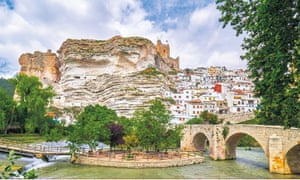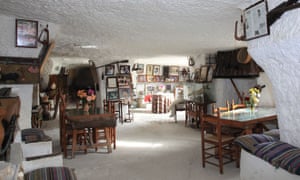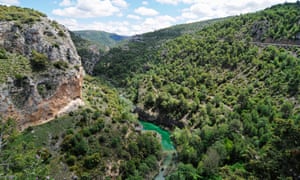NEWS
XUQ EN LA PRESTIGIOSA REVISTA THE GUARDIAN
The Júcar gorge: Spain’s very own grand canyon
This dramatic 40km limestone gorge, off the tourist track in rural Castilla-La Mancha, has historic villages and troglodyte dwellings and, now, a chic new cave hotel
The young woman in Alcalá del Júcar’s tourist office seems surprised when we say we have come from England. “How did you find us?” she asks. “Nobody knows about this place.” Nobody, she means, except the Spanish, and even for them, Alcalá is far from famous.
In La Manchuela, in central Spain, Alcalá is one of a string of villages in the Júcar canyon, a spectacular limestone gorge running for some 40km through the province of Albacete. I more or less fell in love with the place before I got here. First, I’d been seduced by a photograph of Jorquera – a village on a rock that looked so magical, I couldn’t quite believe it wasn’t computer-generated. Then I heard about a new boutique cave hotel nearby (Xuq – more on that later).
And Alcalá, I read (thanks to Google Translate) “is a wonder to discover … a place of unique natural environments and a very unique architecture”.
It has quite a lot in common with Matera – the rock-hewn city in Basilicata, southern Italy, which is currently enjoying a year as a European Capital of Culture. Like Matera, many of Júcar’s villages are carved from the cliffs of a gorge; both have underground tunnels, grotto-like cave dwellings and medieval roots. But while Matera is struggling to cope with visitor numbers, Júcar’s inspiring landscapes (Alcalá was named a site of special historic and artistic heritage in 1982) remain largely unknown. So if you don’t fancy elbowing your way through the Sassi di Matera, this could be a quieter, more adventurous alternative.

We arrive from Alicante – a two-hour drive. One minute we are rolling across the grassy plains of Castilla-La Mancha, the next we plunge into the gorge. On empty roads, hugging the banks of the River Júcar, we loop around giant rocky outcrops, slip under bulges of limestone overhang and zigzag up and down vertiginous cliffs. There are views to take your breath away at every hairpin bend. My husband, Dave, is wishing he’d brought his bike (he says it again – “this is better than the Alps”).
The young woman from the tourist office – Petra, a Slovakian, married to a local lad she met on a kayaking holiday – jumps at the chance to practise her rusty English and takes us on a walking tour of her adopted home.
We begin with the castle, a Moorish fortress perched atop a tower of rock with dizzy views of Alcalá as it tumbles downhill, slipping into folds and fissures of the valley and leaning into its rugged limestone walls. Petra points out the egg-shaped bullring (which may be Roman), the Roman bridge (which isn’t), and the 15th-century bell tower of San Andrés church. Alcalá’s uneven terraces of white and terracotta houses look as though they have been pressed into the rock. Half-house, half-cave seems to be the norm around here.

Casa Cueva el Castillo is a once-ruined cave house that has been restored and turned into a mini-museum. The dug-out rooms once lived in by peasant farmers (nobody seems sure exactly when) have fresh white paint and are filled with rustic furniture, pottery and old farm tools. To add authenticity, there are live chickens in the yard, and a donkey called Margarita in a rock-cut stable.
Donkeys aside, hundreds of Júcar’s caves, just like this one, are still inhabited. There are cave rooms under our feet, Petra tells us, as we walk the cobbled streets down to the river. Some are open to the public – if you can find them.
An inconspicuous doorway leads into the Cave of King Garaden – a vast subterranean palace used as a stronghold in the 12th century, with a 170-metre tunnel that takes us under the castle to a medieval lookout cut high in the gorge. The passage, which is cool, dank and dimly lit, probably hasn’t changed in hundreds of years.
From here a staircase takes us down to Cuevas del Diablo, named after its current owner – El Diablo, a nickname he picked up in childhood. A poet and former bullfighter with a waxed Salvador Dalí moustache, this “devil” has furnished his warren of caves – some of which he dug himself – with a large and eccentric collection of vintage stuff (sewing machines, radios, guns, cash registers, numerous Diablo selfies). At one time, he ran a nightclub here: a glitter ball still sprinkles light on the craggy walls of a cave the size of a ballroom.

The €3 entry fee includes Garaden’s cave, a drink from the bar there and entry to Alcalá’s disused cinema. Another Diablo enterprise, this too is crowded with curious collectables (a stuffed gorilla in a telephone box, rusty farm implements, a horseless cart) but high up on the balcony, rows of hard bench seats and an original projector recall this atmospheric relic’s silent-movie roots.
At Café Masago, in another street, in another cave, at the end of another long tunnel, we eat slow-cooked partridge with white beans and a gazpacho manchego – a rustic La Manchuela stew of rabbit or chicken (or both) cooked with squares of unleavened bread. Seated at a circular window cut into the stone, we are at the penthouse level of the gorge, with views of the river a hundred metres or so below.
The sinuous Júcar is a green snake of a river, flanked by forest, river beaches and allotments: the latter a patchwork of fruit trees, almonds, olives and neat rows of lettuce. Traditionally this was a market garden economy; now the area specialises in adventure sports (kayaking, rafting, rock climbing, hiking, cycling and canyoning among others). Groups of canoeing (often shrieking) children in orange life jackets are a common sight on the river, which offers miles of rocks and rapids stretching all the way to Cuenca, nearly two hours’ drive to the north.
There are several cheap hostales in Alcalá, but we spend the night in one of its cave-house holiday homes. Casa Cueva Las Tinajas de Naya (sleeps six from €300) resembles a normal village house from the outside but inside, three windowless double bedrooms have been scooped out of the rock – dark, womb-like and completely silent, other than the hum of a dehumidifier.

In the morning, we follow the Júcar to Tolosa, a tiny hamlet 6km to the east, where the river widens and the vertical gorge is green with aromatic forests of juniper and pine. The place is deserted, but the stone-built AvenJúcar hostel (bed €32pp B&B) advertises energetic group experiences (such as paddleboarding, rafting and hiking) so it’s probably not always so tranquil.
In the opposite direction, Jorquera – half an hour’s drive from Alcalá, is the walled medieval village whose photograph brought me here. From a bend in the road that climbs out of the gorge, we stop to take a photograph: perched on a lump of rock, with the river wrapped around its base like a moat, Jorquera looks like a floating island.
With one tiny shop and a restaurant-bar that isn’t open, deserted Jorquera seems locked in a time-warp but at the foot of its cliff we find an unexpected pocket of 21st-century cool. A glassy new-build restaurant, La Playa has tables on a jetty over the river, a manmade beach with parasols, a menu of modern takes on Spanish classics (grilled octopus, seafood paella, patatas bravas), decent prices (starters from €8, mains from €14) and staff who speak good English, a rarity around here (at last, no need for Google Translate).A few kilometres further on, we cross the river on a narrow, rather rickety bridge and check into Xuq (suites from €124 B&B), the aforementioned boutique “apart hotel” with eight groovy suites tucked into the walls of the gorge.
The hotel was created by friends Victor Pinedo and Fernando Monteagudo, who left their jobs (in engineering and accountancy), bought a row of rundown, middle-of-nowhere cave dwellings, and embarked on a “new concept in rural tourism”. They took the name from Xuquer (Arabic for Júcar) and jazzed up the cave rooms with memory foam pillows, original art, retro fridges, dinky kitchenettes and designer furniture (the odd Eames chair). Nearly every room has an oversized spa bath (some of them sunk into the rock); some have shower rooms and all feature bumpy walls of natural limestone.

From here there’s plenty of walking and cycling (there are bikes to borrow), and towns and villages to explore. Xuq doesn’t serve food other than a continental breakfast buffet and although all the rooms have a kitchenette, the nearest supermarket is in Alcalá.
One of the owners’ objectives, they say, is to spread the word about their region – and it seems to be working. The hotel is full, mostly with young couples swapping Madrid or Valencia for the soothing rush of the river in its canyon, and the smell of pines and wild rosemary. Overtourism is a long way off.
• Accommodation was provided by Xuq (doubles from €124 B&B). Alcalá del Júcar is two-and-a-half hours’ drive from Madrid, or just under two hours from Valencia or Alicante. More information from lamanchuelarural.com
Fuente The Guardian: https://www.theguardian.com/travel/2019/aug/17/spain-jucar-gorge-alcala-cave-dwellings-hotel

 English
English

